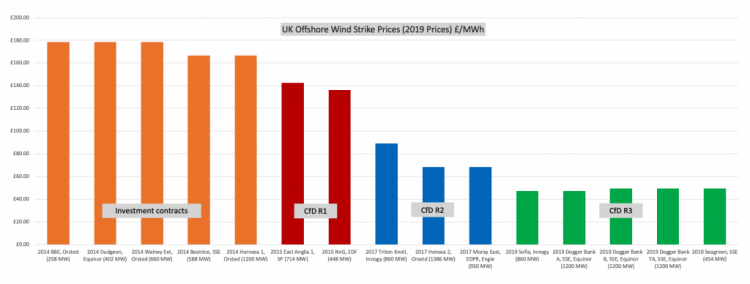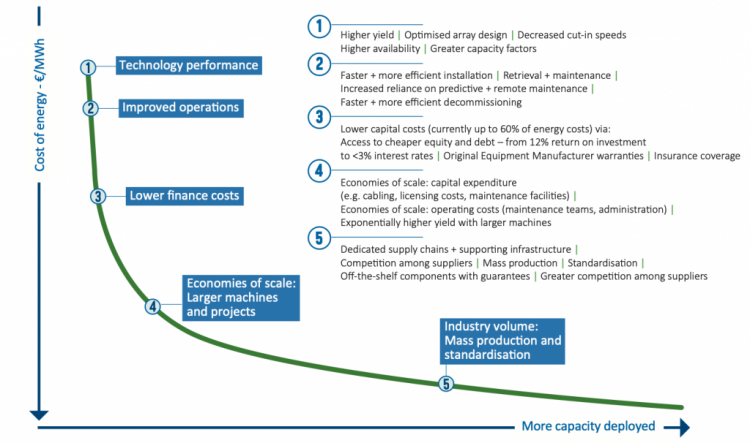The promise of the G7 nations to channel £100bn a year into poorer nations to help address climate change is a clear indication that global warming requires a global approach. An approach that relies on Governments supporting the transition to greener energy, not only within their own borders but across the world.
The solution to our climate crisis as a multifaceted one, based on the delivery of complementary technologies that work alongside each other to deliver clean energy across a wide variety of environments. Ideally, these technologies would utilise sustainable natural resources to balance the electricity system. Whilst low carbon technologies are at different stages in their development and commercialisation there is a real sense of urgency around delivering new technology to meet ambitious but crucial carbon reduction targets.
The pathway to commercialisation
Bringing new and innovative technology through to scale means that technologies must be manufactured and deployed on an entirely commercial basis. This requires competition and large-scale equipment manufacturers to engage with project development partners. Projects have to work financially and have adequate access to capital, insurance and warranties.
Comparisons can be drawn with the development of fixed onshore and offshore wind. Renewable electricity generation in the UK outperformed fossil fuels for the first year ever in 2020 and fixed onshore and offshore wind provided more than half of the country's renewable electricity last year. Fixed offshore wind has rapidly become a fully commercialised product with world-leading companies such as Amazon now investing in offshore wind, including a 350MW offshore wind farm off the east coast of Scotland. We believe reaching NetZero targets and a carbon-neutral economy relies on the commercialisation of the entire suite of renewable energy technologies currently proposed, such as floating offshore wind and wave, to support our carbon reduction aims.
Floating offshore wind and wave - hot on the heels of fixed offshore wind
The UK floating wind sector is on the brink of commercialisation and scale and is poised to expand rapidly over the coming years, offering a significant opportunity for the UK supply chain. The UK government has set a new target of 1 GW floating wind capacity by 2030 and will invest 160 million pounds in UK offshore wind ports and infrastructure to support the further development of offshore wind in the UK.
Prime Minister Boris Johnson commented; "Our seas hold immense potential to power our homes and communities with low-cost green energy and we are already leading the way in harnessing its strengths"
Industry modelling shows the floating wind sector could support at least 17,000 jobs, £33.6bn of GVA and UK export value of at least £230m by 2031 and £550m by 2050. Further afield it has been estimated that the value of global floating wind projects that are planned or under development which amounts to a capital expenditure of over 80 billion in the period up to 2035. It is estimated that wave power alone could add a net positive contribution to the UK economy of £4bn and support 8,100 jobs by 2040.
Offshore wind and wave energy represent a vast source of untapped renewable energy globally and floating technology is crucial to opening up that resource. Floating foundations represent a game-changer for harnessing ocean energy.
Delivering at scale and driving down the cost of energy
When it comes to discussing energy generation the metric used to compare different approaches is Levelised Cost of Energy (LCOE) which represents the minimum price that a unit of energy needs to be sold for to offset the cost of production over the lifetime of the project and provide an acceptable return on investment. Less mature technologies may not yet have benefited from ongoing development and economies of scale and can be subject to a higher cost of capital.
The Contracts for Difference (CfD) scheme is the government's main mechanism for supporting low-carbon electricity generation. CfDs incentivise investment in renewable energy by providing developers of projects with higher upfront costs and long lifetimes with direct protection from volatile wholesale prices, whilst also protecting consumers from paying increased support costs when electricity prices are high.
Developers are paid a flat indexed rate for the electricity they produce that represents the difference between the strike price' (a price for electricity reflecting the cost of investing in a particular low carbon technology) and the reference price' (a measure of the average market price for electricity in the GB market). Figure 1 shows how the strike price of UK offshore wind prices has fared from investment contracts through the last three rounds of the UK Government's Contracts for Difference.

Figure 1 - UK Offshore Wind strike prices
The benefits of supporting economies of scale and the drivers of cost reduction are well understood and Figure 2 demonstrates how ocean energy could experience the same cost reductions that fixed onshore wind and other renewable technologies have. Breaking the LCOE barrier of £100/MWh represents a significant milestone for new renewable energy technologies.

Figure 2 - Cost reduction drivers are well understood and field-tested (Source : Ocean Energy Europe)
Comparisons to equivalent technologies for floating platforms indicates that Marine Power Systems' unique and patented platform technology, with a combined wind and wave ability, is extremely cost-effective when deployed at scale and is forecast to be cost-competitive with fixed offshore wind.
The right place at the right time
The commitment of the UK Government to enable 1 GW of floating offshore wind development in UK waters and upcoming rounds of UK Contracts for Difference, coupled with Marine Power Systems timely technology development and the fact that our flexible technology can be configured to harness wind and wave energy either as a combined solution or on their own in deep water creates what they believe is a very positive pathway to success. The potential of deployment of UK based technology into significant, commercial-scale arrays in UK waters creates geographic and commercial opportunity upon which Marine Power Systems is focused.
About the author
Sue Barr, Non-executive Director, Marine Power Systems
Sue brings over 20 years' experience in the marine energy sector. She is Chair of the Marine Energy Council and has extensive expertise across government policy, revenue support & market intelligence










